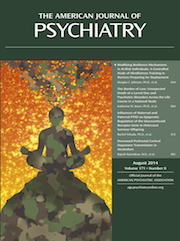Suicide Attempt by Poisoning Using Nicotine Liquid For Use in Electronic Cigarettes
To the Editor: In general, poisoning by nicotine intoxication appears to be relatively rare, but suicide guides available on the Internet (1) suggest this type of poisoning as a means of committing suicide, and suicide attempts by nicotine ingestion appear repeatedly.
We report here on a 24-year-old German man with a depressive disorder and a sexual identity disorder who was admitted to the emergency ward after trying to poison himself by ingesting one capsule of the nicotine liquid used in electronic cigarettes that contained 180 mg of nicotine. Immediately after ingestion, he called an ambulance and reached the hospital within 30 minutes. The patient reported that about 10 minutes after ingestion he started vomiting. Nausea continued for a few hours, but no more vomiting was observed. The patient received 3,000 mg p.o. of charcoal. Within the first hour of treatment, his reported dizziness decreased. Initial blood pressure measurements indicated a slight hypertension, and tachycardic heart rates were observed. Both symptoms vanished within the next 3 hours.
No other severe physiological reactions could be observed, including seizure or other neurological symptoms, and no specific psychiatric symptoms such as hallucinations appeared. Other than a leukocyte count of 15,000/µl, laboratory tests did not reveal any abnormalities.
There may be deaths caused by fatal nicotine ingestion because suicide guides recommend this method, but nicotine poisonings are often not detected as such (2). Since ingestion of cigarettes does not result in death in most cases (3), the new preparation of nicotinic fluids may increase the risk of fatal nicotine ingestions. The involuntary vomiting 10 minutes after ingestion has to be considered the first sign of poisoning, but unfortunately, neither nicotine nor cotinine was detected in blood samples taken from the patient.
Our case demonstrates that the preparation of nicotine as liquid for electronic cigarettes provides a serious new way to attempt suicide by ingesting this substance. New preparations of drugs inevitably lead to new medical cases in which the substances are involved, as shown by an increasing number of accidental ingestions of nicotine for electronic cigarettes by children (4). Since communication via the Internet is now more commonly used in developed countries, we suspect that the reported case may only be the first, and that there are more to come.
1 : Internet suicide guidelines: report of a life-threatening poisoning using tobacco extract. J Emerg Med 2010; 38:610–613Crossref, Medline, Google Scholar
2 : Two UK suicides using nicotine extracted from tobacco employing instructions available on the Internet. Forensic Sci Int 2010; 199:e9–e13Crossref, Medline, Google Scholar
3 : [The lethal ingestion of cigarettes in adults: does it really exist?]. Dtsch Med Wochenschr 2005; 130:1491–1493 (German)Crossref, Medline, Google Scholar
4 : 2012 Annual Report of the American Association of Poison Control Centers’ National Poison Data System (NPDS): 30th Annual Report. Clin Toxicol (Phila) 2013; 51:949–1229Crossref, Medline, Google Scholar



